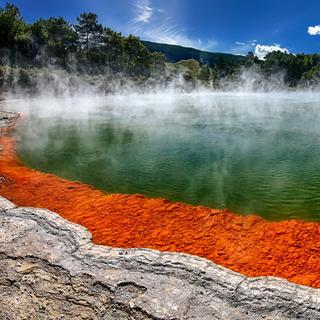Upper Hutt weather and climate in 2025
Day
20 °C
Night
12 °C
Sea
15 °C
Precipitation
112 mm
in month
Rainy days
10 days
in month
Daylight
15 hours
average
Sunshine
6 hours
average
Humidity
78 %
Weather charts for Upper Hutt
Find more destinations like this
Closest destinations for Upper Hutt
Closest cities for Upper Hutt
Weather overview for Upper Hutt
Weather overview
Upper Hutt (New Zealand) is a place with a mild climate. Temperatures during the day are in the range from 11 °C (52 °F) in July to 22 °C (71 °F) in February. Temperatures during the night go from 4 °C (39 °F) in July to 13 °C (55 °F) in February. The least rainy month in Upper Hutt is February with its 8 days of rain, the rainiest month is June, when it rains 14 days.
January weather
The rise of the day temperature can be observed, with its value of 21 °C (70 °F) in Upper Hutt, and the night temperature rises similarly to the previous month too, the value of this measure is 13 °C (55 °F). There is pending tourist season. The number of rainy days descent's start could be observed. The maximum of the number of sun hours (without clouds) is observable, with its value of 7 hours. The minimum of the humidity is observable in this month.
February weather
The tourist season is close to its peak in Upper Hutt. The maximum of the day temperature can be noticed, the value of this measure is 22 °C (71 °F), and the maximum of the night temperature can be noticed too, with its value of 13 °C (55 °F). The number of rainy days reaches its minimum, the value of this measure is 8 days, and the rainfall amount reaches its minimum as well in February. The beginning of the descent of the number of sun hours (without clouds) could be noticed, with its value of 7 hours.
March weather
The tourist season is taking place in Upper Hutt. The day temperature starts to descent, its value is 20 °C (68 °F), and the night temperature descent's start could be observed as well, with its value being 11 °C (53 °F). The beginning of the rise of the number of rainy days could be noticed, its value is 9 days, and the beginning of the rise of the rainfall amount could be noticed too, with its value of 91 mm (3.57 in). The number of sun hours (without clouds) descents similarly to the previous month, the value of this measure is 5 hours.
April weather
The descent of the day temperature can be observed, its value is 17 °C (63 °F) in Upper Hutt, and the night temperature descents similarly to the previous month too, its value is 9 °C (48 °F). The rise of the number of rainy days can be observed, its value is 10 days. The number of sun hours (without clouds) continues to descent, the value of this measure is 4 hours.
May weather
The rise of the number of rainy days can be observed, with its value of 12 days in Upper Hutt, while the beginning of the rise of the rainfall amount could be noticed in this month. The night temperature descents similarly to the previous month, with its value being 7 °C (44 °F), and the day temperature descents similarly to the previous month as well, the value of this measure is 15 °C (58 °F). The number of sun hours (without clouds) descents similarly to the previous month, the value of this measure is 3 hours.
June weather
The descent of the day temperature can be observed in Upper Hutt, and the night temperature continues to descent too, the value of this measure is 5 °C (41 °F). The rise of the rainfall amount can be observed, its value is 142 mm (5.59 in), while the maximum of the number of rainy days can be noticed in June. The minimum of the number of sun hours (without clouds) can be noticed in this month. The maximum of the humidity is observable in this month.
July weather
The minimum of the day temperature is observable, with its value of 11 °C (52 °F) in Upper Hutt, and the minimum of the night temperature is observable too. The maximum of the rainfall amount can be noticed in July.
August weather
The day temperature rise's start could be observed, with its value of 12 °C (54 °F) in Upper Hutt, and the beginning of the rise of the night temperature could be noticed too in this month. The beginning of the descent of the rainfall amount could be noticed, with its value of 122 mm (4.81 in). The number of sun hours (without clouds) rise's start could be observed in this month.
September weather
The number of rainy days descent's start could be observed, with its value of 12 days in Upper Hutt, while the rainfall amount descents similarly to the previous month, with its value being 100 mm (3.94 in). The rise of the day temperature can be observed, its value is 14 °C (58 °F), and the night temperature rises similarly to the previous month too, with its value being 7 °C (44 °F). The number of sun hours (without clouds) continues to rise, the value of this measure is 4 hours.
October weather
The number of rainy days starts to rise, the value of this measure is 13 days in Upper Hutt, and the beginning of the rise of the rainfall amount could be noticed too, with its value of 107 mm (4.23 in). The day temperature rises similarly to the previous month, and the night temperature continues to rise too, its value is 8 °C (47 °F). The number of sun hours (without clouds) continues to rise.
November weather
The day temperature continues to rise, the value of this measure is 17 °C (63 °F) in Upper Hutt, and the rise of the night temperature can be observed too, with its value of 10 °C (49 °F). The number of rainy days descent's start could be observed, with its value of 11 days, and the rainfall amount starts to descent as well, the value of this measure is 101 mm (3.97 in). The number of sun hours (without clouds) continues to rise. The maximum of the wind speed is observable in November.
December weather
The rise of the day temperature can be observed, its value is 20 °C (67 °F) in Upper Hutt, and the night temperature rises similarly to the previous month too, with its value being 12 °C (53 °F). The tourist season is about to start. The beginning of the rise of the rainfall amount could be noticed, with its value being 112 mm (4.39 in). The maximum of the day length can be noticed, with its value of 15 hours.
FAQs
Is January a good month to visit Upper Hutt?
In January in Upper Hutt, there are ideal conditions for a vacation. You can expect just 8 days of rain during the month, taking an umbrella is not necessary. There are some people, who may feel a slight chill at 21 °C (70 °F), but others will feel perfectly fine. The temperature of 13 °C (55 °F) at night may make it better to dine inside or to put on more clothes for a dinner outside.
What is the temperature in Upper Hutt during the day in February?
In February in Upper Hutt, the average daily temperatures will be 22 °C (71 °F). A comfortable temperature for most people, where it is neither too cold nor too hot, and a large number of activities can be carried out comfortably, including sunbathing by the water. Lighter clothing will be suitable - shorts, skirts, t-shirts, jackets; a light sweater and long trousers may also be useful.
Is March part of the wet season in Upper Hutt?
No, there is no wet season in March in Upper Hutt - you can expect 9 days of rain during the month.
What is the sea temperature in April in Upper Hutt?
The temperature of the sea in Upper Hutt in April is 16 °C (60 °F). This is a sea temperature for resilient people only, most people won't enjoy swimming in such cold water or will have to use a wetsuit for water activities. In absolute terms, the decrease compared to the last month is 1 °C (34 °F).
Is there a dry season in Upper Hutt in May?
No, May is not a dry month in Upper Hutt, expect rain approximately 12 days in a month.
How windy is Upper Hutt in September?
An average wind scale that can be expected in Upper Hutt in September is 5.
How many hours of sun to expect in Upper Hutt in October?
In October in Upper Hutt, you can expect around 5 hours of sunshine. That's 1 hour more than in the previous month. This is an increase of 28 %.
What is the night temperature in November in Upper Hutt?
The average night temperature in November in Upper Hutt is 10 °C (49 °F). The nights will be cool, layers of clothes will be needed for evening and morning walks, the hotel should be equipped with heating. This indicator is higher by 1 °C (35 °F) than in the previous month.
What is the average number of rainy days in Upper Hutt in December?
In December in Upper Hutt, we can expect 10 days to be rainy, that is, days when precipitation exceeds 2 mm (0.08 in). Converted to days of the week, this means that it will occur on an average of 2.4 days of the week, or in general - 35 % days.
We make the most from 40 years of historical weather data to predict the best weather conditions.
Deciding on where to go for a holiday is hard sometimes. Get inspired by the most popular destinations.
We aggregate data from combining multiple weather sources to ensure accuracy of the highest order.







